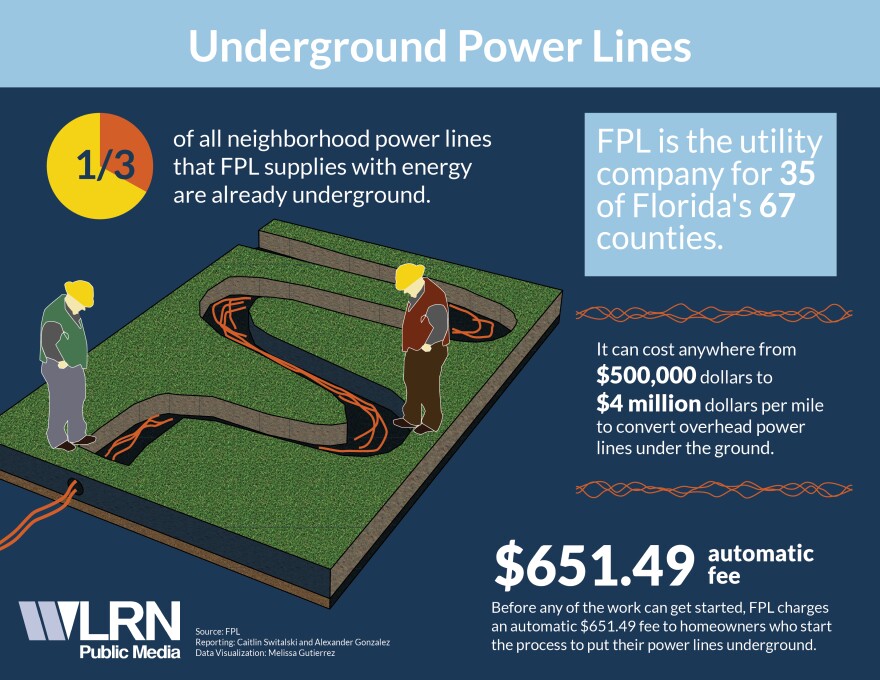For residents of one West Palm Beach neighborhood, some ground-shuddering repetitive banging is a small price to pay for power that stays on even during high winds.
The residents of Bradley Court are in the midst of a Florida Power and Light project to bring their power lines underground, where tree-toppling gusts have a slimmer chance of shutting off the lights.
Both FPL and South Florida government officials acknowledge “undergrounding” power lines isn’t a “magic elixir” that will solve hurricane power outage woes. Undergrounded lines can take longer to repair in areas prone to flooding or storm surge, where the mix of water and electricity gets dangerous.
But FPL said along streets like Bradley Court, they could keep the power on longer, and get it back up sooner.
Read more: Are Underground Power Lines Really The Solution To Power Outages In South Florida?
Frank Padrón has lived on Bradley Court for more than 50 years, and has two houses there currently – his and his father’s. He said the neighborhood’s grappled with power outages during hurricanes and more run-of-the-mill windstorms.

During Hurricane Irma, he said the power was out for nearly two weeks.
“You don’t know what you have until it’s gone – electricity is very important,” he said. “This [undergrounding] is like a gift.”
Padrón’s neighborhood hits the three criteria FPL looked for in deciding which lines to move below ground: outages during Hurricane Irma or Matthew, outages because of trees or other vegetation bringing down the lines, and overall problems with reliability – even outside of major storms.
Undergrounding the lines won’t keep Padron and his neighbors totally safe from trees. When the wind is strong enough to uproot a tree entirely, it can sometimes bring the underground lines up with it.
But Bryan Olnick, FPL’s vice president of distribution operations, said the lines already underground during recent hurricanes fared much better than their above-ground counterparts. During Hurricane Irma, he said, undergrounded lines in neighborhoods like Padrón’s performed almost 85 percent better – which means they were that much less likely to lose power.
FPL is moving lines below the surface in 430 Florida neighborhoods as part of its three-year undergrounding pilot program. Of those, 107 will be in Miami-Dade County, 90 in Palm Beach and 86 in Broward.
FPL spokesman Bill Orlove said the utility company won’t release more specific locations because all are contingent on each affected resident signing off – during the pilot phase, if even one FPL customer on the street says no to putting a power line below ground, FPL moves on to another neighborhood. He said they’ve already had a few of those cases.

After the three-year pilot program wraps up in 2021, Olnick said FPL expects to have the data to decide where and how to move more neighborhoods’ power lines underground.
“Our goal is to make this the approach that we want to use in the future for the next phase of our hardening efforts,” he said.
Here in Palm Beach County, some have already started a more universal approach. Palm Beach, set off from the rest of the county by the Intracoastal Waterway, is in the middle of trying to put every single power line in the town – and all of the town's neighborhoods – underground.
It’s a $90 million undertaking that residents pre-paid for, or will pay through a special assessment tax for the next 30 years. Undergrounding all of the lines started in July 2017, and will take seven to eight years to complete.
The pilot program is covered by the electricity rates FPL customers already pay – there's no additional cost to the selected neighborhoods to have their power lines undergrounded. FPL spokesman Bill Orlove said the data they collect during the pilot program will help determine next steps for how to go about, and pay for, undergrounding other lines after the pilot.
In the meantime, participating in the pilot program isn't the only way to get lines put underground. Palm Beach moved to do it themselves, and pay for it themselves – an option also available to neighborhoods and individual customers, not just entire towns. Some areas are requiring developers to underground utility lines in new developments, and factor that into building costs.
This story has been corrected to clarify how undergrounding power lines outside of and after the pilot program can be paid for.





